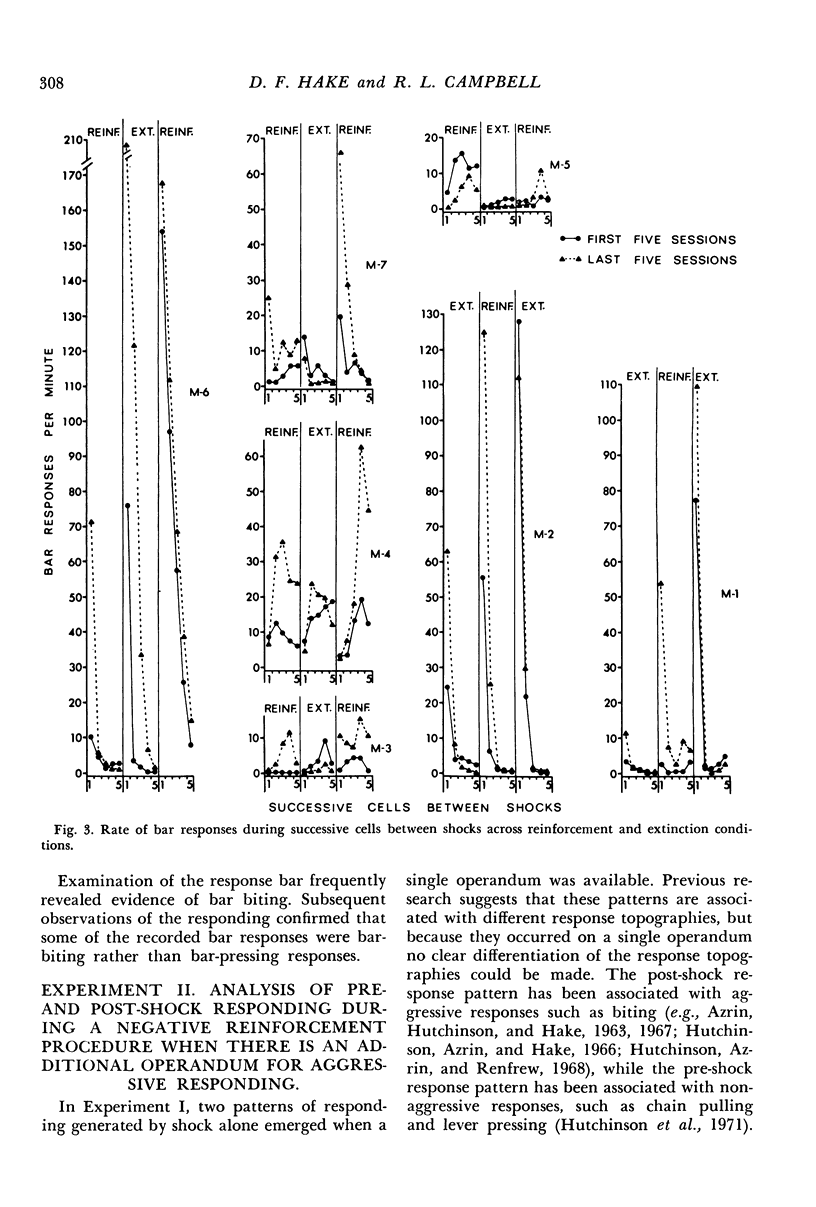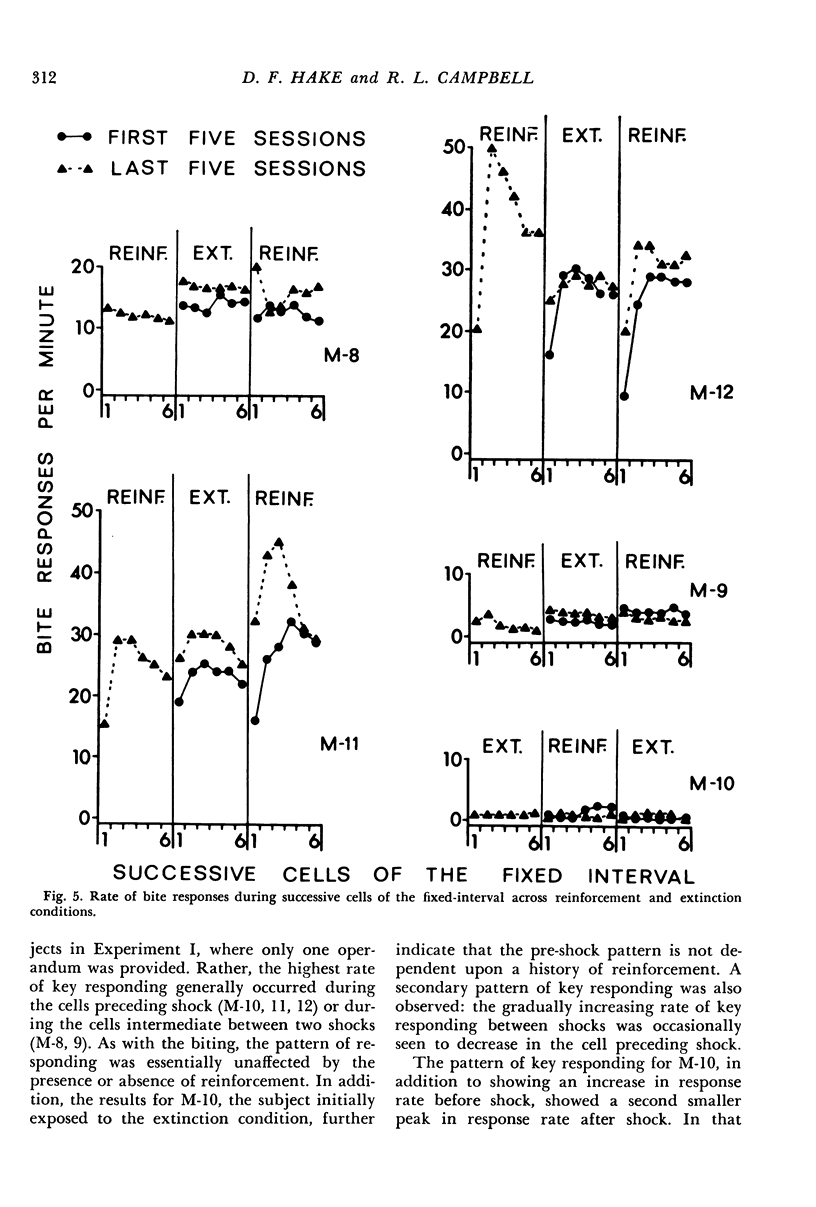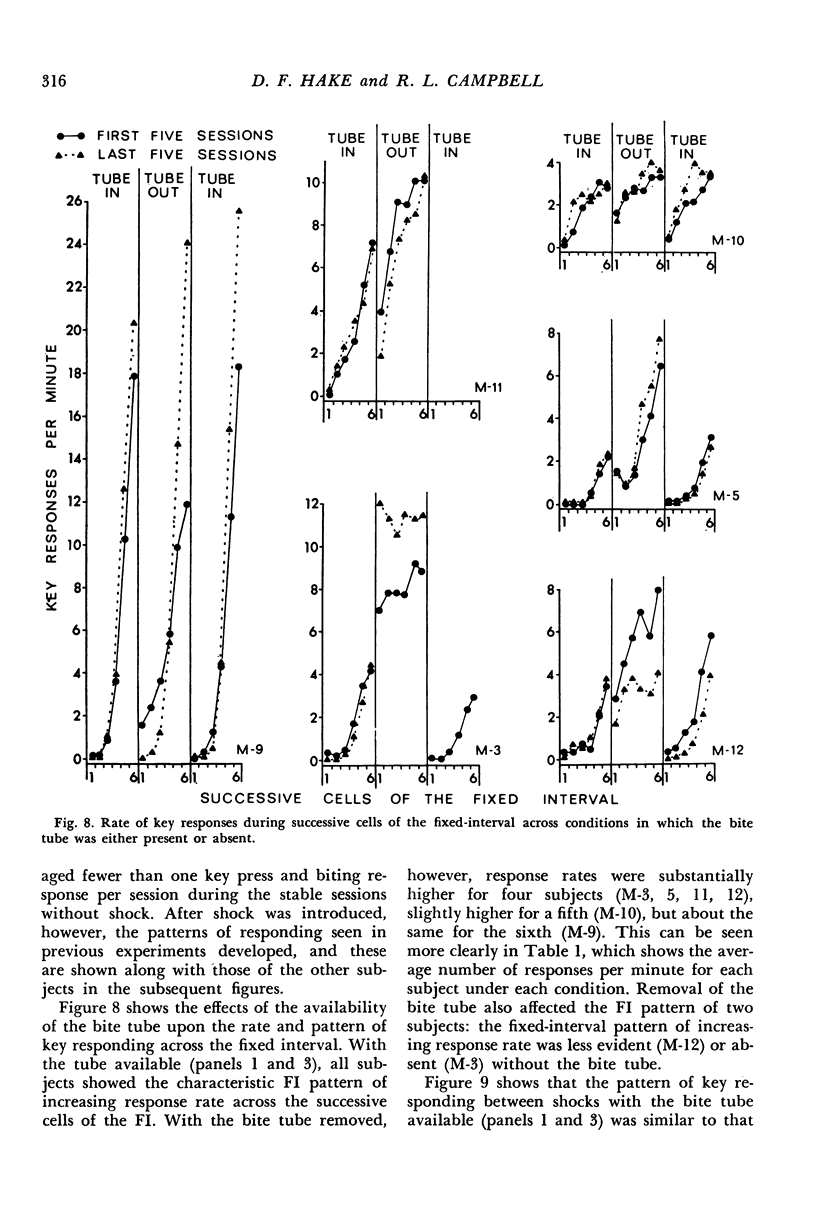Abstract
Bar-pressing (Experiment I) or key-pressing (Experiments II and III) responses of monkeys were reinforced according to a fixed-interval schedule of negative reinforcement: the first response after a fixed interval of time terminated regularly spaced shocks for a fixed time designated as the reinforcement period. During extinction, shocks continued during the reinforcement period. That there were two types of responding generated by shock alone was indicated by (1) the level of responding maintained during extinction relative to conditions without shock, (2) the stability of two between-shock response patterns across reinforcement and extinction conditions, and (3) the development of these two between-shock patterns without a history of reinforcement. Subjects developed either a pre-shock or a post-shock response pattern when only the bar was available. However, when both a bite tube, an operandum requiring an aggressive topography, and a recessed key, an operandum that did not require an aggressive topography, were provided, the post-shock pattern was observed in tube biting and the pre-shock pattern was observed in key pressing. Removal of the bite tube produced post-shock key responding similar to that observed when only the bar was available. The displacement of post-shock, aggression-motivated responding confirmed the confounding effect of shock-generated responding in negative reinforcement procedures, and suggests that the use of concurrent response alternatives would reduce such confounding.
Full text
PDF




















Selected References
These references are in PubMed. This may not be the complete list of references from this article.
- AZRIN N. H., HUTCHINSON R. R., HAKE D. F. PAIN-INDUCED FIGHTING IN THE SQUIRREL MONKEY. J Exp Anal Behav. 1963 Oct;6:620–620. doi: 10.1901/jeab.1963.6-620. [DOI] [PMC free article] [PubMed] [Google Scholar]
- Azrin N. H., Hake D. F. Positive conditioned suppression: conditioned suppression using positive reinforcers as the unconditioned stimuli. J Exp Anal Behav. 1969 Jan;12(1):167–173. doi: 10.1901/jeab.1969.12-167. [DOI] [PMC free article] [PubMed] [Google Scholar]
- Azrin N. H., Hutchinson R. R., Hake D. F. Attack, avoidance, and escape reactions to aversive shock. J Exp Anal Behav. 1967 Mar;10(2):131–148. doi: 10.1901/jeab.1967.10-131. [DOI] [PMC free article] [PubMed] [Google Scholar]
- Barfield R. J., Sachs B. D. Sexual behavior: stimulation by painful electrical shock to skin in male rats. Science. 1968 Jul 26;161(3839):392–393. doi: 10.1126/science.161.3839.392. [DOI] [PubMed] [Google Scholar]
- Brown P. L., Jenkins H. M. Auto-shaping of the pigeon's key-peck. J Exp Anal Behav. 1968 Jan;11(1):1–8. doi: 10.1901/jeab.1968.11-1. [DOI] [PMC free article] [PubMed] [Google Scholar]
- Byrd L. D. Responding in the cat maintained under response-independent electric shock and response-produced electric shock. J Exp Anal Behav. 1969 Jan;12(1):1–10. doi: 10.1901/jeab.1969.12-1. [DOI] [PMC free article] [PubMed] [Google Scholar]
- Caggiula A. R., Eibergen R. Copulation of virgin male rats evoked by painful peripheral stimulation. J Comp Physiol Psychol. 1969 Nov;69(3):414–419. doi: 10.1037/h0028245. [DOI] [PubMed] [Google Scholar]
- HAKE D. F., AZRIN N. H. An apparatus for delivering pain shock to monkevs. J Exp Anal Behav. 1963 Apr;6:297–298. doi: 10.1901/jeab.1963.6-297. [DOI] [PMC free article] [PubMed] [Google Scholar]
- Hake D. F. Actual versus potential shock in making shock situations function as negative reinforcers. J Exp Anal Behav. 1968 Jul;11(4):385–403. doi: 10.1901/jeab.1968.11-385. [DOI] [PMC free article] [PubMed] [Google Scholar]
- Hake D. F., Powell J. Positive reinforcement and suppression from the same occurrence of the unconditioned stimulus in a positive conditioned suppression procedure. J Exp Anal Behav. 1970 Nov;14(3):247–257. doi: 10.1901/jeab.1970.14-247. [DOI] [PMC free article] [PubMed] [Google Scholar]
- Hutchinson R. R., Azrin N. H., Hake D. F. An automatic method for the study of aggression in squirrel monkeys. J Exp Anal Behav. 1966 May;9(3):233–237. doi: 10.1901/jeab.1966.9-233. [DOI] [PMC free article] [PubMed] [Google Scholar]
- Hutchinson R. R., Azrin N. H., Renfrew J. W. Effects of shock intensity and duration on the frequency of biting attack by squirrel monkeys. J Exp Anal Behav. 1968 Jan;11(1):83–88. doi: 10.1901/jeab.1968.11-83. [DOI] [PMC free article] [PubMed] [Google Scholar]
- Hutchinson R. R., Renfrew J. W., Young G. A. Effects of long-term shock and associated stimuli on aggressive and manual responses. J Exp Anal Behav. 1971 Mar;15(2):141–166. doi: 10.1901/jeab.1971.15-141. [DOI] [PMC free article] [PubMed] [Google Scholar]
- KELLEHER R. T., RIDDLE W. C., COOK L. PERSISTENT BEHAVIOR MAINTAINED BY UNAVOIDABLE SHOCKS. J Exp Anal Behav. 1963 Oct;6:507–517. doi: 10.1901/jeab.1963.6-507. [DOI] [PMC free article] [PubMed] [Google Scholar]
- Kelleher R. T., Morse W. H. Schedules using noxious stimuli. III. Responding maintained with response-produced electric shocks. J Exp Anal Behav. 1968 Nov;11(6):819–838. doi: 10.1901/jeab.1968.11-819. [DOI] [PMC free article] [PubMed] [Google Scholar]
- McKearney J. W. Fixed-interval schedules of electric shock presentation: extinction and recovery of performance under different shock intensities and fixed-interval durations. J Exp Anal Behav. 1969 Mar;12(2):301–313. doi: 10.1901/jeab.1969.12-301. [DOI] [PMC free article] [PubMed] [Google Scholar]
- McKearney J. W. Maintenance of responding under a fixed-interval schedule of electric shock-presentation. Science. 1968 Jun 14;160(3833):1249–1251. doi: 10.1126/science.160.3833.1249. [DOI] [PubMed] [Google Scholar]
- Meltzer D., Brahlek J. A. Conditioned suppression and conditioned enhancement with the same positive UCS: an effect of CS duration. J Exp Anal Behav. 1970 Jan;13(1):67–73. doi: 10.1901/jeab.1970.13-67. [DOI] [PMC free article] [PubMed] [Google Scholar]
- Miczek K. A., Grossman S. P. Positive conditioned suppression: effects of CS duration. J Exp Anal Behav. 1971 Mar;15(2):243–247. doi: 10.1901/jeab.1971.15-243. [DOI] [PMC free article] [PubMed] [Google Scholar]
- Morse W. H., Mead R. N., Kelleher R. T. Modulation of elicited behavior by a fixed-interval schedule of electric shock presentation. Science. 1967 Jul 14;157(3785):215–217. doi: 10.1126/science.157.3785.215. [DOI] [PubMed] [Google Scholar]
- Powell R. W., Peck S. Persistent shock-elicited responding engendered by a negative-reinforcement procedure. J Exp Anal Behav. 1969 Nov;12(6):1049–1062. doi: 10.1901/jeab.1969.12-1049. [DOI] [PMC free article] [PubMed] [Google Scholar]
- Rachlin H. Autoshaping of key pecking in pigeons with negative reinforcement. J Exp Anal Behav. 1969 Jul;12(4):521–531. doi: 10.1901/jeab.1969.12-521. [DOI] [PMC free article] [PubMed] [Google Scholar]
- Stretch R., Orloff E. R., Dalrymple S. D. Maintenance of responding by fixed-interval schedule of electric shock presentation in squirrel monkeys. Science. 1968 Nov 1;162(3853):583–586. doi: 10.1126/science.162.3853.583. [DOI] [PubMed] [Google Scholar]
- ULRICH R. E., AZRIN N. H. Reflexive fighting in response to aversive stimulation. J Exp Anal Behav. 1962 Oct;5:511–520. doi: 10.1901/jeab.1962.5-511. [DOI] [PMC free article] [PubMed] [Google Scholar]
- Williams D. R., Williams H. Auto-maintenance in the pigeon: sustained pecking despite contingent non-reinforcement. J Exp Anal Behav. 1969 Jul;12(4):511–520. doi: 10.1901/jeab.1969.12-511. [DOI] [PMC free article] [PubMed] [Google Scholar]


